Knowing beef internal temperatures is an important skill any grill master, chef, or home cook should utilize. These temperatures let you know if your meat has reached your desired level of doneness, but also if it is safe to eat. Everything you need to know on the varying levels of doneness as well as ideal internal temperatures for different types of beef can be found right here.
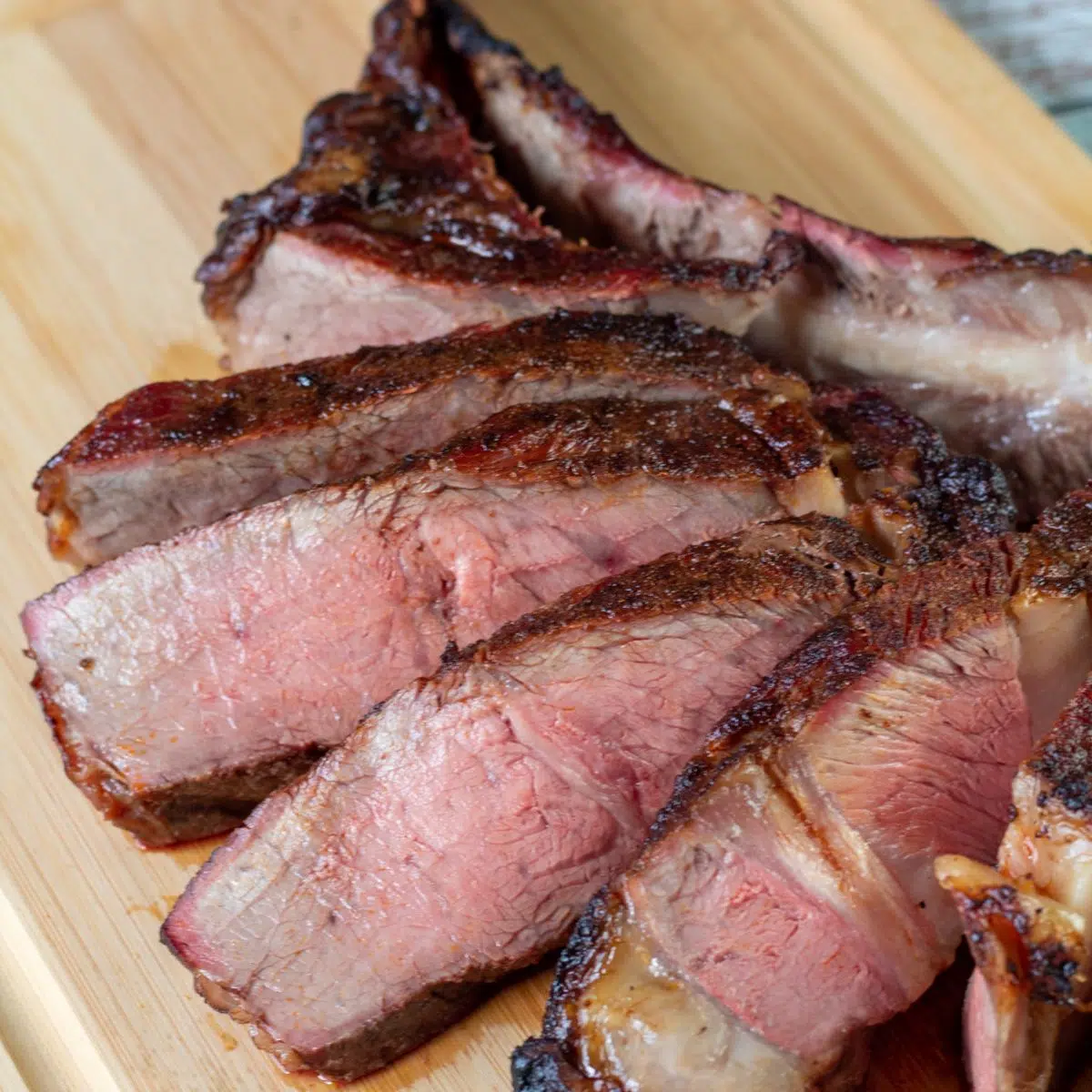
Jump to:
- Ideal Beef Internal Temperatures
- Internal Temperatures for Beef Roast or Steak
- Internal Temperatures for Ground Beef
- How to Measure the Internal Temperature of Beef
- How to Get the Most Accurate Internal Temperature
- How to Measure the Internal Temperature of Ground Beef
- Beef Internal Temperatures Reference Chart
- 🥩 Beef Recipes
- 📖 Recipe Card
- 💬 Comments & Reviews
Ideal Beef Internal Temperatures
Beef - it's what's for dinner. Many of us remember this slogan that put beef back on the dinner plates of families across America. Not that all of us needed convincing though, since beef has always been a delicious and versatile main dish in our homes.
However, unlike many types of meat that have one set internal temperature, there are several different temps for beef. Therefore, even if you have always known exactly what temperature to cook prime rib or a pot roast, you may not be as familiar with the other internal temps for beef.
Internal Temperatures for Beef Roast or Steak
The USDA recommends that beef be cooked to an internal temperature of 145°F (63°C). This temperature is the minimum temperature at which the USDA guarantees possible bacteria have been killed by the heat.
While this is the recommended internal temperature, it is not the only temperature that you can use as a guide. Cooking a steak or roast to145°F (63°C) is what is considered medium-well. A medium-well piece of beef is only slightly pink in the center with brown surrounding it. This is a bit too done for many people.
Many people prefer to eat their beef medium or even medium-rare. While the USDA does not recommend any beef be eaten below 145°F (63°C) - most chefs agree that a quality cut of meat can safely be eaten medium or medium-rare. However, this only applies to cuts of beef that have been minimally processed like steak, prime rib, or roast.
Here is a quick guide on what temperature will help you cook a piece of beef exactly how you prefer it.
- Rare: 115 to 120°F (46-49°C)
- Medium-Rare: 120 to 125°F (49-52°C)
- Medium: 130 to 135°F (54-57°C)
- Medium-Well: 140 to 145°F (60-63°C)
- Well-Done: 150 to 155°F (66-68°C)
Internal Temperatures for Ground Beef
While there is some flexibility around the recommended 145°F (63°C) for steaks and other whole cuts of beef, there is not any flexibility when it comes to ground beef. In fact, ground beef has an even higher recommended internal temperature than a well-done steak.
The recommended internal temperature for ground beef is 160°F (71°C). The reason for this recommendation is due to the process of making ground beef. Grinding the beef creates more opportunities for bacteria to develop in the meat. Therefore, eating under-cooked ground beef increases the risk of foodborne illness.
Therefore, ground beef needs to always be cooked to 160°F (71°C) to guarantee it is safe to eat.
How to Measure the Internal Temperature of Beef
The most accurate way to check the internal temperature of any type of meat is to use a meat thermometer. Many of us are familiar with using a thermometer to check the internal temperature of a Turkey on Thanksgiving or a Prime Rib for Easter. The extra care to check the temperature of these types of meat is because they are for a celebration, and we want to make sure that the meat is perfectly cooked.
While having a perfectly cooked bird or roast for the holidays is important for the flavor it is also important for safety. We typically use the meat thermometer to guarantee we have properly cooked the meat to make it safe for our guests.
This same attention for checking the internal temperature with a thermometer should be given any time you cook beef (or any other meat). Whether it be a juicy steak or a delicious hamburger, a meat thermometer is the only way to know for sure you have reached the desired internal temperature.
>>>See All Of My Tasty Recipes Here!<<<
How to Get the Most Accurate Internal Temperature
Getting a perfectly cooked piece of beef isn't just about using a thermometer, but how you use it! The first step is to always insert the meat thermometer into the thickest part of the meat. The thickest part is the last to cook. Therefore, it will give you the most accurate temperature.
Once the thermometer is inserted, let it sit for about 30 seconds. This allows the thermometer to accurately read the temperature. With larger cuts of meat, slowly pull the thermometer back about a ¼ inch to get a second reading. This will help to see if the meat has cooked evenly throughout.
What Temperature to Look for on the Thermometer
Above, I gave you the final internal temps to you want for each level of desired doneness. However, the temperature you are looking for on the thermometer is going to be lower than the recommended temperature! This is because you want to give the beef time to rest after cooking in the heat.
Therefore, if you are aiming for a classic medium-well steak that is recommended to be cooked to 145°F (63°C) then you only want to cook it until the thermometer reaches 140°F (60°C).
Internal Temperatures at which to remove the beef from the heat.
- Rare: 115°F (46°C)
- Medium-Rare: 120°F (49°C)
- Medium: 130°F (54°C)
- Medium-Well: 140°F (60°C)
- Well-Done: 150°F (66°C)
- Ground Beef: 155°F (68°C)
Once your beef has reached five degrees below the recommended temperature, remove it from the heat. Follow the next steps to let the meat rest and continue to cook internally.
How to Let the Meat Rest
Beef will continue to cook internally once it is removed from the heat. Therefore, to avoid overcooking the meat it is important to take it out of the oven (or off the stove or grill) a little bit early.
After you remove the beef from the heat cover it in tin foil. This will keep the heat inside and help it to keep cooking. If cooking burgers or steaks, remove them from the pan/grill and place them on a plate. Cover with foil. Larger cuts of meat like a roast can be left in the pan. Place a foil tent over the roast.
How long you let the meat rest depends on how big the cut is. A roast can rest for 20-30 minutes. However, a steak or burger may only need 10-15 minutes before serving.
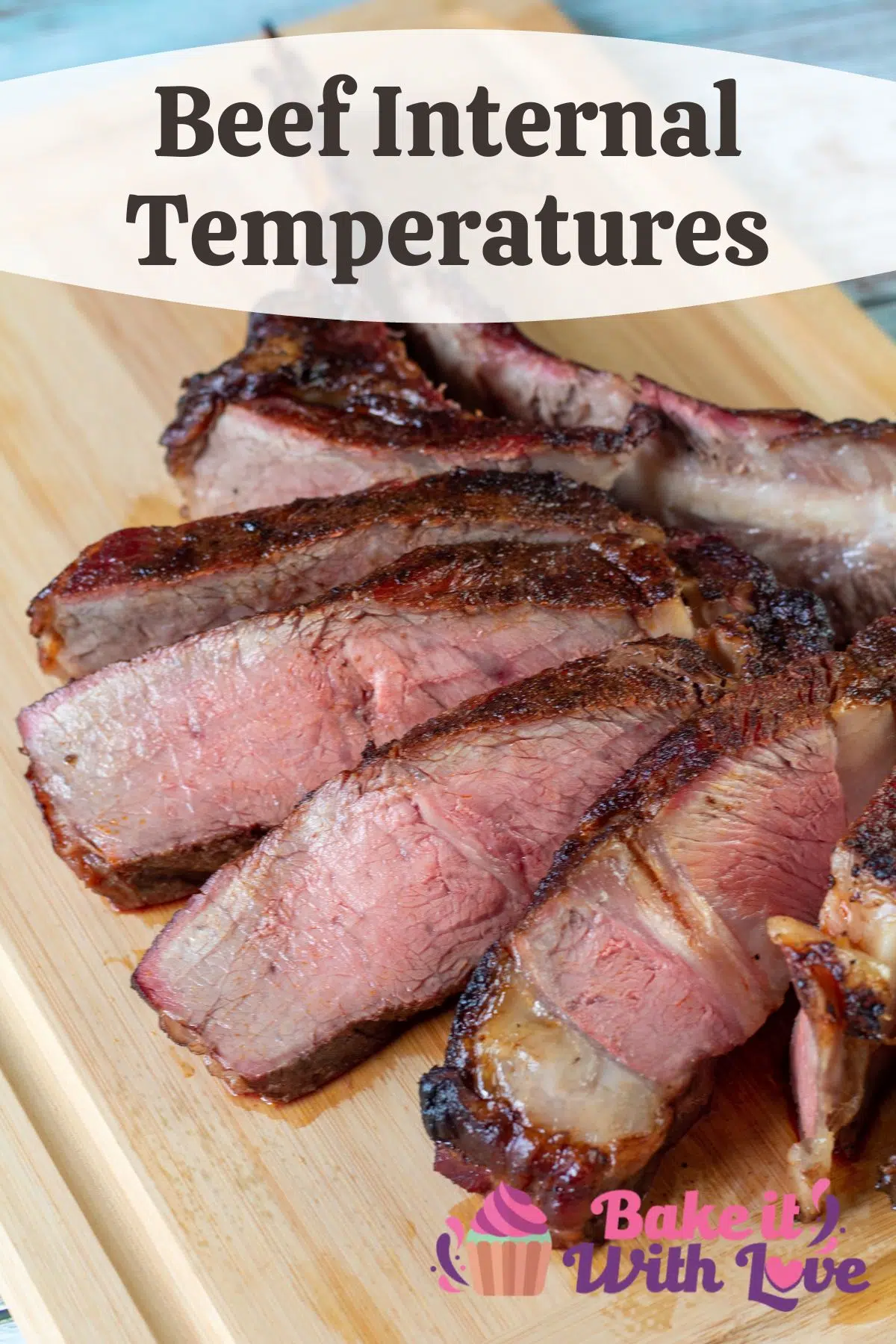
How to Measure the Internal Temperature of Ground Beef
If ground beef is used to make hamburgers, then a meat thermometer can easily be used. Simply follow the directions above. However, if you are cooking the ground beef in a skillet for something like spaghetti sauce you won't be able to use a thermometer.
In this case, it is important to thoroughly stir and cook the ground beef until all the pieces are brown. Make sure to do this before adding any seasonings or sauce to tell the meat is cooked.
Even if you are adding ground beef to a casserole to bake in the oven, make sure it is fully cooked in a skillet first.
Whether cooking a large roast, a single steak, or a ton of burgers, taking time to measure the temperature of each piece of beef will ensure that everything not only tastes good but is safe to eat.
Beef Internal Temperatures Reference Chart
| Level of Doneness | Internal Temperature | Internal Description |
|---|---|---|
| Extra-Rare or Blue-Rare ('bleu') | 80-100°F (26-38°C) | Not warm internally with a deep red color. |
| Rare | 115°F (46°C) | The very center is bright red, turning more pink in color toward the exterior. It should be slightly warm throughout. |
| Medium-Rare | 120-125°F (49-52°C) | A bright pink center that turns brown as it reaches the exterior. It should be slightly hot. |
| Medium | 130-135°F (54-57°C) | A light pink center with brown exterior and hot throughout. |
| Medium-Well | 140-145°F (60-63°C) | Mostly grey/brown throughout with a thin strip of pink in the center. Hot all the way through. |
| Well-Done | 150-155°F+ (66-68°C+) | The steak is grey/brown and hot throughout. |
| Brisket | 165-175°F (74-79°C) | Brisket is ready when it pulls apart easily. |
| Pot Roast | 180°F (82°C) | Pot roast is ready when it is 'fork tender' and pulls apart easily. |
| Ground Meat (Patties, Meatloaf, Meatballs, etc.) | 160-165°F (71-74°C) | Use a meat thermometer horizontally to check the internal temperature of ground beef. |
🥩 Beef Recipes
- Grilled Beef Heart Steaks - These grilled beef heart steaks are juicy and delicious, don't knock it 'til you try it!
- Oven Roasted Prime Rib - An oven roasted prime rib roast is the perfect way to serve a crowd on any special occasion.
- Grilled T-Bone Steak - A juicy T-bone steak whipped up on the grill is every steak lover's dream!
- Bavette Steak - Thinly sliced bavette steak is melt-in-your-mouth tender!
- Hamburger Steaks - Hamburger steaks slathered in brown mushroom gravy are a classic family dinner.
- Chicken Fried Cube Steak - This Southern classic chicken fried steak is the ultimate comfort food!
These beef internal temperatures are the key to making perfectly cooked beef that is safe to eat! Tell us which of our fabulous beef recipes you plan on trying by leaving a comment below!
Do you love a recipe you tried? Please leave a 5-star 🌟rating in the recipe card below and/or a review in the comments section further down the page.
Stay in touch with me through social media @ Pinterest, Facebook, Instagram, or Twitter! Subscribe to the newsletter today (no spam, I promise)! Don't forget to tag me when you try one of my recipes!
📖 Recipe Card
Beef Internal Temperatures: Smoked Beef Roast (+ Ideal Internal Temps For More Beef Recipes)
Ingredients
- 4 lbs Eye of Round (or use another lean beef cut suitable for roasting like Bottom Round or Top Round)
- 2 tablespoon olive oil (extra virgin or use Worcestershire sauce)
- 1 tablespoon sea salt
- 1 teaspoon black pepper
- 1 tablespoon paprika
- 1 teaspoon garlic powder
- 1 teaspoon onion powder
(Note: 2x or 3x only changes the ingredient list)
Instructions
- Brush olive oil (or use Worcestershire sauce) to coat your beef roast cut.
- In a small bowl or a plastic storage bag, combine the seasoning ingredients including salt, pepper, paprika, garlic powder, and onion powder. Apply the seasoning to your beef, massaging the blend into the meat. *Allow the meat to come to room temperature, try to give the beef at least an hour to warm before smoking.
- Load the pellet hopper or chip basket with your desired wood chips. Preheat your smoker to 225 degrees F (107 degrees C).
- Place seasoned beef into your preheated smoker directly onto the grill. If you have a meat probe to monitor the internal temperature, insert the probe into the middle of the roast. *See notes for proper placement of meat probe.
- Smoke for approximately 2 hours at 225 degrees F (107 degrees C), or 30 minutes per pound. Internal temperature should be 120-125 degrees F (49-52 degrees C) for RARE, 125-135 degrees F (54-57 degrees C) for MEDIUM RARE, and 135-140 degrees F (57-60 degrees C) for MEDIUM.
- Remove from your smoker and loosely cover with aluminum foil for about 30 minutes to rest the smoked beef roast.
- Once rested remove the foil, slice against the grain, and serve.


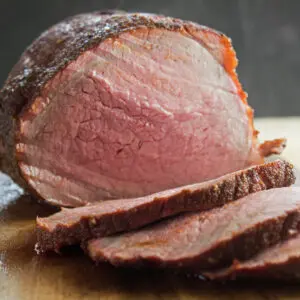
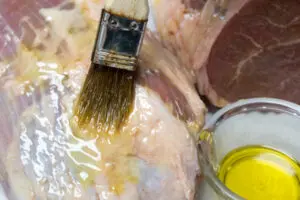
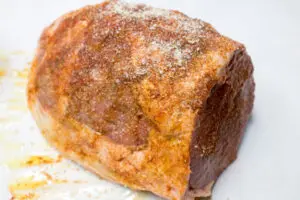
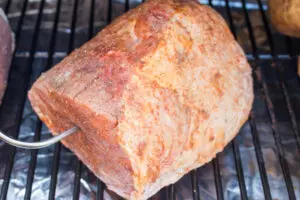
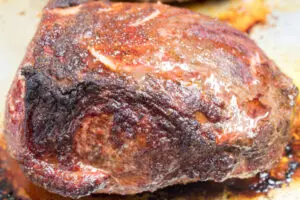
Steven Cobb says
I was able to quickly find internal beef temperatures that I needed. Thanks kindly.